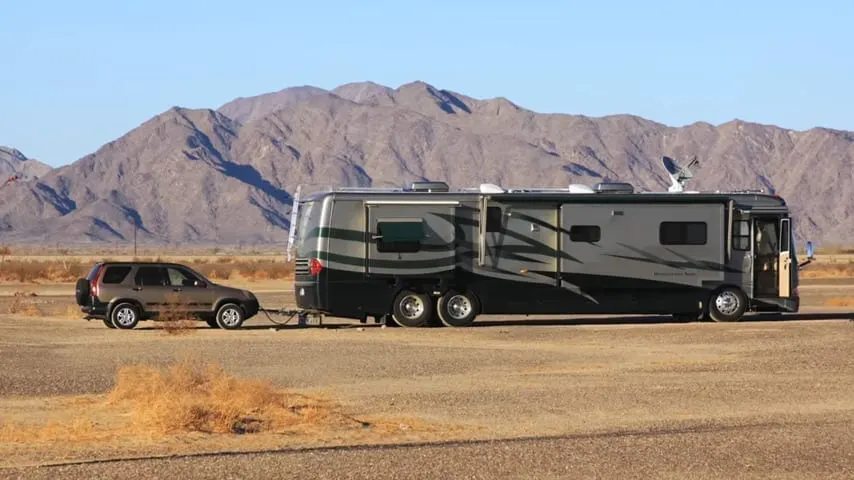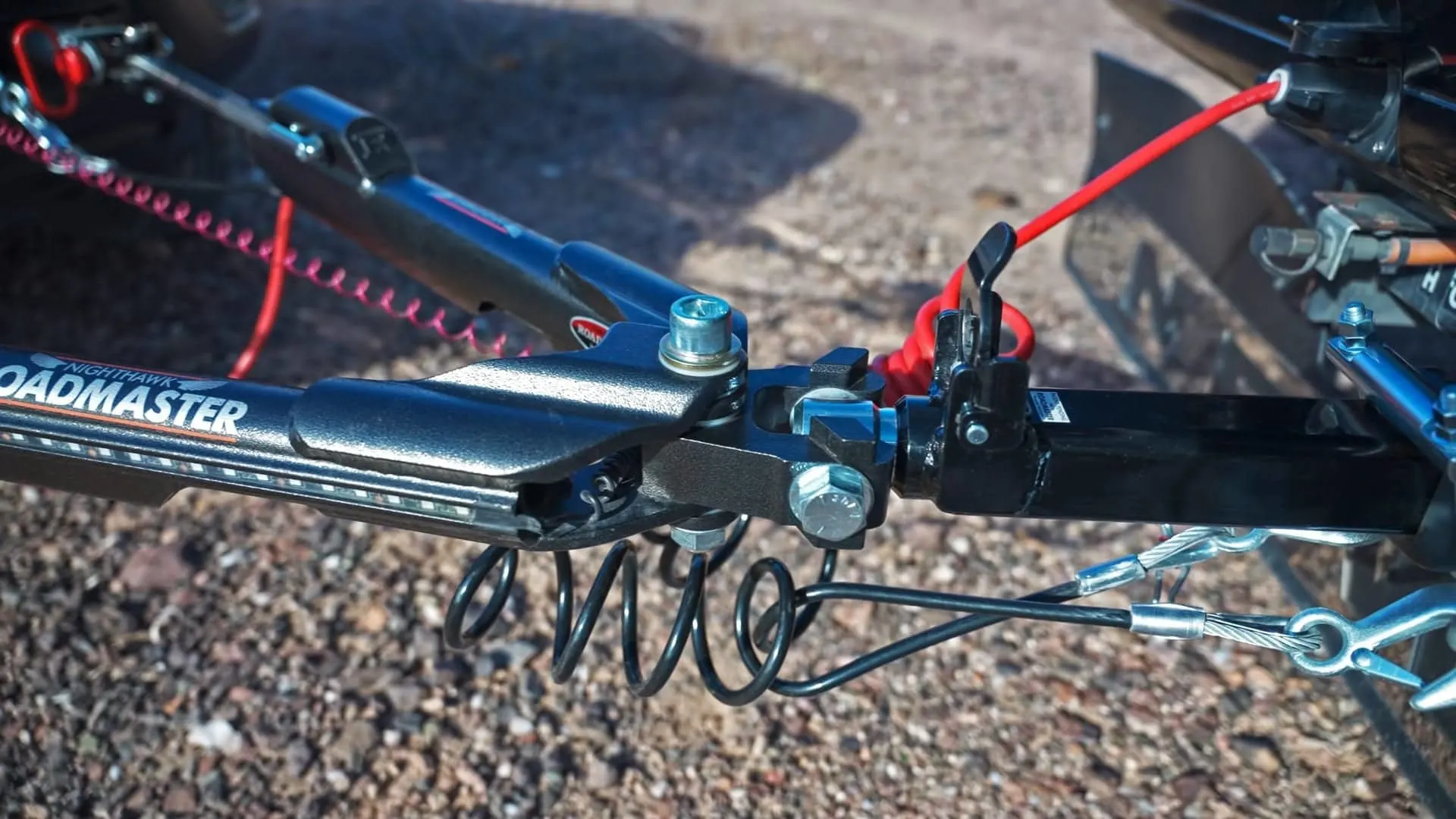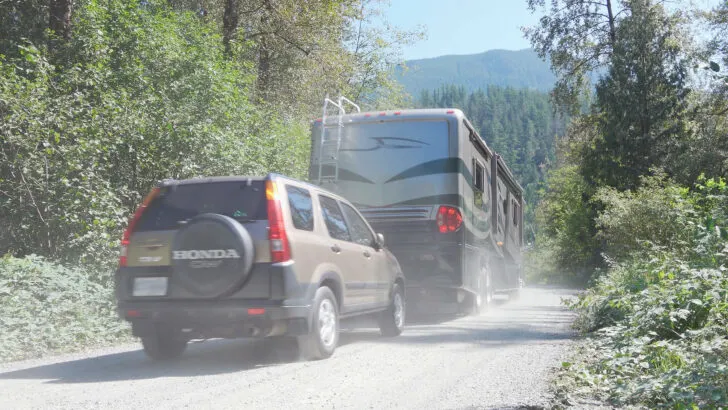As owners of a large Class A motorhome, we flat tow a Honda CR-V behind our rig and have done so for nearly two decades now. Yes, the SAME Honda CR-V! We bought it brand new in 2003… specifically to tow behind us when we became full-time RVers. It’s been a fantastic vehicle for us and has never left us stranded, not even once. Even though we’ve used it’s all-wheel-drive capability to travel off-road in places that might bring our sanity into question! Our little CR-V has handled all of our adventures with ease.
We love this midsize SUV because it’s practical, comfortable, offers a lot of room for passengers and cargo, gets good gas mileage, and is as easily navigated along challenging terrain as it is on city streets. It’s fantastic for day trips and for errands that may find us loading it up with the loads of food and other necessities in preparation for a long boondocking trip.
Because of all of these factors (comfort, practicality, reliability, and durability), lots of RVers choose to flat tow a Honda CR-V behind their motorhomes.
But how do we tow our Honda CR-V? Are there options? Can we tow it with all four wheels on the ground? Are there restrictions when you flat tow a Honda CR-V? In today’s post, we’re asking and answering all of these questions, and more!
Can a Honda CR-V Be Flat Towed?
The answer to this question is an emphatic YES… with one important caveat. It depends on the model and model year. Our 2003 CR-V can be flat towed, and that’s exactly how we’ve chosen to tow it for many years. Unfortunately, due to drivetrain changes, only Honda CR-Vs before the 2015 model year are flat-towable (as in 2014 and older). So, if you can buy a Honda CR-V that is a pre-2015 model, you will be able to flat tow it. Newer models cannot be flat-towed.

We’ve flat towed the same 2003 Honda CR-V for nearly two decades now, and it’s been the perfect toad for us.
Will Flat Towing Hurt Your CR-V?
As long as you use the proper procedure for flat towing, no harm will come to your Honda CR-V from the process of flat towing.
You can flat tow a Honda CR-V safely at speeds up to 65 mph. With all four wheels on the ground, you’ll avoid damage to the 4WD system. And, of course, you’ll want to use a quality tow bar.
On that topic, check out our video about how to connect and disconnect a tow bar:
Does Honda Approve of Flat Towing a CR-V?
The pre-2015 Honda CR-V is approved by Honda for flat towing as long as you follow the proper procedure as laid out by Honda. Following are the steps Honda specifies to prepare to tow an automatic transmission CR-V.
NOTE: be sure to check your owner’s manual, as there may be slight differences between model years.
- Connect the CR-V to your RV’s tow bar, making sure all connections are tight and secure
- To prepare for towing, you’ll need to start the engine and depress the brake, then shift the transmission through all the gears one at a time (P/R/N/D/2/1).
- Next, shift it into drive, and finally into neutral. Let the engine run for about three minutes, then shut it off.
- Make sure the parking brake is released.
- Turn the ignition key to the accessory position (ACC 1) so the steering wheel is unlocked.
- The next step is, in our experience, where the owner’s manual is incorrect. They say to leave the key in the accessory position (ACC 1) to keep the steering wheel unlocked, and turn off the radio and any other accessories to avoid draining the battery. But... after turning the key to the accessory position, the steering wheel remains unlocked, even when the key is turned back to the OFF position. As long as you don’t remove the key, the wheel stays unlocked. So our procedure for nearly two decades has been the same on this one: turn the key to the accessory position, then back to off, and leave the key in the ignition, but turned off. It’s then our (good) habit to turn the wheel a little to the left & right to confirm it’s still unlocked. In all these years, we’ve never accidentally started to drive away with the wheels still locked…. which would of course be an unfortunate self-inflicted wound. Don’t do that!
- If you tow more than 8 hours in one day, repeat steps 1 & 2 above before continuing to tow to lubricate the automatic transmission.
Our CR-V happens to be a stick shift model. That’s not by accident, as we prefer those (Peter has never actually owned a single automatic transmission car in his entire life). The benefit to our manual transmission CR-V when it comes to flat-towing is that there’s even less to do to prepare to tow, other than a couple of pretty obvious ones: transmission in neutral; parking brake off; steering wheel unlocked. That’s it. There’s surely not a car on the market that’s any quicker and easier to prepare to flat tow!
What Speed Should You Drive While Flat Towing?
It’s worth repeating that in order to safely flat tow a Honda CR-V or any other vehicle, you should travel at speeds no higher than specified by the manufacturer. In our case, that’s 65 MPH. Again, check the owner’s manual for your specific model year of CR-V to ensure that didn’t change.
Tips for Flat Towing Your Honda CR-V
Following are a few tips to keep in mind when flat towing your Honda CR-V:
- Use a good quality RV tow bar system.
- Pay attention to your Gross Vehicle Weight Rating (GVWR) if you’re carrying cargo in your tow vehicle.
- Connect and disconnect on a level surface when possible.
- When you pull up to the rear of the RV, align the vehicle as straight as possible with the tow bar
- Be sure to attach the safety cables and the breakaway cable!

Safety cables are a critical component of any tow bar system.
Conclusion
Having flat towed our 2003 since it was new, we can certainly vouch for the fact that the Honda CR-V is a fantastic tow vehicle from a number of perspectives. It carries 5 passengers and a generous amount of cargo; it’s practically bullet-proof; it gets a pretty solid 25 MPG under most conditions; it has been incredibly reliable and has required very minimal maintenance over the years; and it can maneuver easily through city streets or take us over some pretty insane terrain when we’re in adventure mode, especially since our is an all-wheel-drive model.
The CR-V has long been a popular tow vehicle for many good reasons, even with it only being an option on the used market now. On that note, if Honda releases a new CR-V that’s flat towable again, we’ll probably be first in line. Ours is still in great shape, but nearly 20 years is a long time for a couple of car nuts to go without a new one!
With the right combination of a pre-2015 Honda CR-V as your tow vehicle and a good tow bar system, you’ll enjoy bringing your toad along as safely and seamlessly as we do.
Geek Out with Us Every Week
Join our newsletter to learn about all things RV-related. Every week we offer free tips, tricks, product reviews, and more to our online community of RVers. Whether this is your first time on the road or you’re a seasoned expert, we’d love for you to geek out with us!


Tom Hogan
Monday 4th of December 2023
Do you use anything to keep your CR-V’s battery charged? I assume the portable braking system I’ll be using (Patriot BRK2022) will deplete my Honda’s battery.
Tom Hogan
Sunday 10th of December 2023
@TheRVgeeks, Thank you so much for this information! I've also heard people talk about putting in a separate 12V power adapter for the brake system that is also hooked into the 12V positive wire coming from the RV. Is there an advantage of one method over the other?
TheRVgeeks
Monday 4th of December 2023
Hi Tom. Great question! Our towed braking system (the Invisibrake by Roadmaster) trickle charges the CR-V's battery by drawing power from the tail-light circuit, helping to ensure that the car's battery doesn't get depleted by the Invisibrake's built-in compressor that's supplying vacuum for the CR-V's braking system. As a result, we've never had an issue with the car's battery.
The Blue Ox Patriot doesn't have that feature that we know of... so you'll likely want to see if you have a spare wire in your 7-pin umbilical cable (one is commonly available) or confirm if you have a 12V positive wire coming across already. Once confirmed/configured, you can use that 12V positive lead coming across the tow connection to install a DC-DC converter that will use 12V power from the towing vehicle (the RV) to charge the towed car's battery.
You'll need/want the DC-to-DC converter to ensure that (1) you don't have power flowing back the other way if the towed car's battery is at a higher voltage than the RV's (which can be the case due to voltage drop across the umbilical) and (2) you don't overcharge the towed car's battery because the RV's alternator is pumping out too much power (the DC-to-DC converter can be set for the right battery chemistry for your towed car's battery, allowing you to charge between different chemistries without problem).
You'll also want that DC-to-DC converter to be an "isolated" one (separate ground & positive connections for both the RV side and CR-V side of the power connections) to ensure that you don't have trouble (a non-isolated DC-to-DC converter could have trouble since it relies on both sides of the power sharing a common ground, and again the voltage drop across the umbilical could make the grounds appear to be different between RV and towed). Here's an 10A isolated DC-to-DC charger available from Battle Born Batteries that should do the job nicely.
Janelle Plowright
Monday 1st of May 2023
I'd love to geek out with you so please ad me to your list for weekly mailings!
TheRVgeeks
Monday 1st of May 2023
Hi Janelle. That's great! The best way to join is to use the subscribe form you'll find on our Subscribe page (or that pops up when viewing a page here on the site... or that's located at the bottom of every page in the footer, look for the yellow rounded box)!
Paul Rich
Wednesday 21st of September 2022
Thanks for the great article. Just bought my first CRV-EX (2014 AWD Automatic) Getting a little confused with different "drive times" while towing that I've found on the web. Most say Honda recommends not towing for over 300 miles at a time. If so, then at a stop, go through the P-N-D-2-1 drill, and then you're good for another 300 miles. Other articles state, like you do, that Honda states 8 hours is the limit. Checked my manual and it states the 8 hour maximum routine with the instructions to remove the 7.5 A accessory fuse while towing. Like you recommend, I think I will choose what my manual states. Any ideas why so many articles/comments are stating Honda says 300 miles?
TheRVgeeks
Thursday 22nd of September 2022
Hi Paul. Not sure why other sites would recommend the “300 mile limit” for the Honda… like you, we’ve always deferred to what’s listed in the owner’s manual. It’s possible that there was a change for a particular model year… or that once ONE place listed the 300 mile, other’s just copied them!
Zanna
Tuesday 5th of October 2021
We're replacing our Jeep Wrangler that burned up while flat towing. Looking at a 2010 CRV. What do we need to look for when buying a CRV to flat tow? We currently have a towing system much like the blue ox on the RV and will want to use it with the CRV. Are we making a good choice?
TheRVgeeks
Tuesday 5th of October 2021
Yikes! So sorry to hear about your Jeep, Zanna. Hope nobody was hurt. CR-V model years up through 2014 are flat towable. 2015 was the first year of the CVT (continuously variable transmission), which is why any 2015 and newer ones can't be flat towed. We LOVE our CR-V, and personally know several other RVers who tow them, too. They are so popular that we know people who have done the same thing you're considering — buying a used one specifically to tow. We think you're making a great choice, as long as you do the same kind of due diligence you would on any used car — have a qualified mechanic do a thorough pre-purchase inspection, review the service records, etc. Safe travels!
Joan Rickmeier
Wednesday 22nd of September 2021
Question I have a 2013 CRV. So If I’m understanding correctly, I turn the key to off while towing? Not kept in accessory mode?
TheRVgeeks
Wednesday 22nd of September 2021
Hi Joan!
The owner’s manual is generally the ultimate arbiter of what’s required for each year, make and model of car to be flat towed. But in our case, the way the instructions about the ignition key are worded has led us to change part of it slightly. Here’s what it says for our 2003 5-speed manual-transmission CR-V:
“Leave the key in the ignition switch and the ignition switch in ACCESSORY (I) so the steering wheel does not lock.”
They specifically state that the reason for leaving our key in the ACC position is to prevent the steering wheel from locking. But here’s the thing — turning our key to ACC and then back to OFF and then LEAVING THE KEY IN THE IGNITION has the same effect: the steering wheel will not lock. After the key has been turned to ANY position, it’s the REMOVING of the key that allows the wheel to lock. So for the past 18+ years, we’ve turned the key on, then back to off, and simply made sure to NOT remove the key, and we’re good to go.
I think that Honda specifies that we’re supposed to leave the key in Accessory so that there’s less chance you could accidentally have the steering wheel lock. Since looking at the key when we’re towing does not give any visual indication of whether the wheel will lock or not (you can’t tell if the key was turned on, then off, or if it was simply inserted into the ignition but not turned on (which would ABSOLUTELY allow our wheel to lock)! If you always leave it in ACC, it HAS to be unlocked. But we never do that, and instead have three simple checks to do inside the car before towing: 1) Parking brake off, 2) Trans in neutral, 3) Key turned on then off, then left in place (and twist the wheel left & right to confirm it doesn’t lock).
This means we never have to worry about the battery getting drained, since the key is turned OFF while towing. Our Roadmaster InvisiBrake also trickle charges the car’s battery when our RV’s parking lights are on (we always drive with RV headlights on 24/7 for safety). So even if we did leave the key in ACC, the battery wouldn’t drain.
In your situation, with only automatic transmissions available in 2013, there are more steps required (which is typical for automatics). Here’s a link to your manual: http://techinfo.honda.com/rjanisis/pubs/OM/0A1313/0A1313OM.PDF
The wording about the ignition key is slightly different than ours. On page 235, step 6 reads:
“Leave the ignition switch in ACCESSORY (I). Make sure the steering wheel does not lock.”
We’re assuming that the only reason the key is left in ACC is the same as ours… to assure that the wheel doesn’t lock. If you do the same thing we do (key on, then off, then left in the ignition) then twist the wheel left and right to confirm that it doesn’t lock, you SHOULD be fine. BUT, we can’t 100% confirm that there isn’t some additional reason Honda wants you to keep your car in ACC mode (for instance, to keep some component in the transmission powered up during towing).
We’d suggest that getting this information from Honda could prove very difficult, but there’s one thing we’re sure of: you can’t go wrong following the owner’s manual, even if it means your car battery will slowly drain from leaving the key in ACC mode.
If you haven’t yet installed a braking system, and want to take advantage of the trickle charging feature we mentioned, we highly recommend the InvisiBrake, and driving with the RV’s lights on 24/7 for safety. One note… the InvisiBrake is a permanent installation, not transferable between cars.
Sorry for how long this is. Hope it all makes sense and helps. Safe travels!